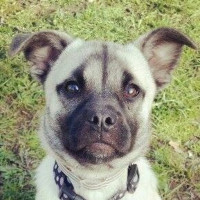Appearance of the Hug
|
| Your Hug will have the physical characteristics of both the Siberian Husky and the Pug. Their exact appearance is unpredictable. The Hug will be larger than the Pug and may weigh from 13.5 to 27 kilos. It will have a stocky, muscular body. His Pug side may give him a short muzzle with a flattened face, although his face is not as "pushed" as the Pug's. Your Hug may have a curly or straight tail. Ears can be flat and hanging or pointed. Some Hugs have the Pug's dark melanic mask (mask-like appearance). Their coats are smooth and can be medium to long. Hugs' eyes may be larger than what we see in the Siberian Husky, but will not be as prominent as the Pug. Eye color can be brown, blue or black. Sometimes a Pug can have two different eye colors. |
Temperament of the Hug
|
| The personality and character of the Hug will be a combination of the two temperaments of its parents. Siberian Huskies are outgoing, cheerful and friendly. They are gentle, kind and adore children. Siberian Huskies are not aggressive towards dogs and are not wary of strangers. They love to play and explore the outside world, and will enjoy hiking, biking and jogging. They are not recommended for new dog owners, as they require extensive obedience training and lots of exercise. Without the opportunity to expend energy, the breed can develop behavioral problems such as excessive barking, chewing furniture and urinating in the house. What's more, they're considered escape artists and can't be left alone outdoors. Carlins are charismatic, intelligent and rarely aggressive. They are eager to please. The breed craves and demands attention and affection. They can be a little lazy, which can lead to obesity. Carlins have low to moderate energy levels and are happy to be homely. Carlins are hardy and generally good with other dogs and children. Your Hug will be adorable, charming, intelligent and a happy dog. He'll need lots of attention, play and regular, consistent training. |
Needs and activities of the Hug
|
| Siberian Huskies are a high-energy dog breed, and Pugs tend to have low energy levels. Your Hug can have moderate to high energy levels. When he's a puppy, he'll be more energetic and need more playtime. The Hug is a social dog who will enjoy visiting and making new friends in a dog park. Both the Siberian Husky and the Pug are sensitive to heat stroke. Therefore, during the hot summer months, they should not be walked during the hottest hours of the day. Keep them well hydrated during walks and exercise, and be sure to give them a break in the shade. Hug can live comfortably in an apartment or house, but will be more content with a yard to explore. |
Maintenance of the Hug
|
| The Hug can have a medium to long coat. It should be brushed or combed weekly to remove dead hairs and keep its coat shiny. If your Hug has thick, long hair, it may need to be brushed several times a week to prevent tangling. Nails should be trimmed every month, as overgrown nails can cause the dog pain and can become infected. Daily walks or jogs can help to wear down nails naturally. Soft, floppy ears should be cleaned weekly with earwash. Your vet can recommend the product best suited to your dog and advise you on the safest method of ear cleaning. The Hug should only be bathed when dirty, or every few months. If your Hug has folds on his face, they should be wiped daily, taking care to wipe them well. Hug's teeth should be brushed weekly to prevent tartar build-up and bad breath. The affectionate Hug is a family dog and demands a lot of attention. To avoid boredom when you're not at home, provide him with chew toys. |









 English (United Kingdom)
English (United Kingdom)